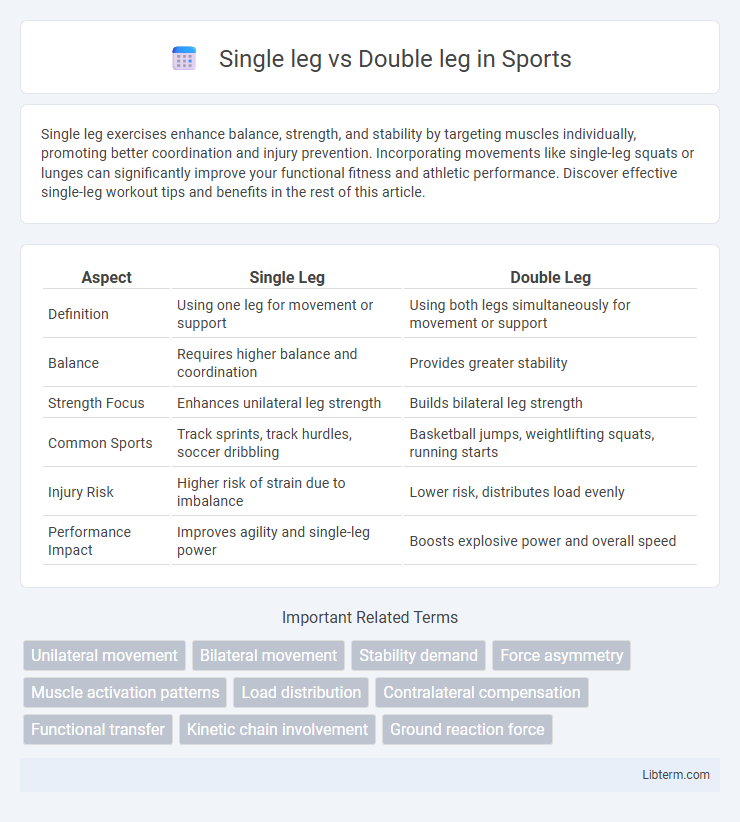Single leg exercises enhance balance, strength, and stability by targeting muscles individually, promoting better coordination and injury prevention. Incorporating movements like single-leg squats or lunges can significantly improve your functional fitness and athletic performance. Discover effective single-leg workout tips and benefits in the rest of this article.
Table of Comparison
| Aspect | Single Leg | Double Leg |
|---|---|---|
| Definition | Using one leg for movement or support | Using both legs simultaneously for movement or support |
| Balance | Requires higher balance and coordination | Provides greater stability |
| Strength Focus | Enhances unilateral leg strength | Builds bilateral leg strength |
| Common Sports | Track sprints, track hurdles, soccer dribbling | Basketball jumps, weightlifting squats, running starts |
| Injury Risk | Higher risk of strain due to imbalance | Lower risk, distributes load evenly |
| Performance Impact | Improves agility and single-leg power | Boosts explosive power and overall speed |
Introduction to Single Leg and Double Leg Movements
Single leg movements emphasize unilateral strength and balance by engaging muscles independently on each leg, enhancing stability and coordination. Double leg movements involve both legs simultaneously, promoting overall power and symmetrical muscle development. These foundational exercises are essential for improving athletic performance, injury prevention, and functional fitness.
Key Differences Between Single Leg and Double Leg Exercises
Single leg exercises primarily target unilateral strength, balance, and stability by isolating each limb, which helps correct muscle imbalances and improves proprioception. Double leg exercises focus on bilateral strength and power, enabling the use of heavier loads and promoting overall muscle symmetry. The key difference lies in single leg movements enhancing functional coordination and injury prevention, while double leg exercises maximize force production and overall muscle mass development.
Biomechanical Analysis of Single vs Double Leg Patterns
Single leg and double leg movement patterns exhibit distinct biomechanical characteristics crucial for performance and injury prevention. Single leg patterns demand greater balance, unilateral strength, and joint stability, typically engaging stabilizer muscles like the gluteus medius and hip abductors more intensively. Double leg patterns distribute load symmetrically, resulting in increased ground reaction forces and enhanced force production through coordinated bilateral muscle activation, often utilized for maximal power output.
Benefits of Single Leg Training
Single leg training enhances balance, stability, and muscular coordination by forcing each leg to work independently, which corrects muscle imbalances and reduces injury risk. It activates core muscles more effectively due to the increased demand for balance and control, promoting improved athletic performance and functional movement. Single leg exercises like Bulgarian split squats and single-leg deadlifts improve joint stability, particularly in the hips, knees, and ankles, leading to better overall lower body strength and posture.
Advantages of Double Leg Training
Double leg training offers enhanced stability and balance by engaging both sides of the body simultaneously, which allows for heavier loads and increased overall strength development. This approach promotes symmetrical muscle growth and reduces the risk of muscular imbalances that can lead to injury during athletic performance or daily activities. Furthermore, double leg exercises improve power output and coordination, making them essential for foundational strength and rehabilitation programs.
Muscle Activation: Single vs Double Leg
Single-leg exercises typically activate stabilizing muscles such as the gluteus medius, hamstrings, and calves more intensively compared to double-leg movements due to the need for balance and unilateral strength. Double-leg exercises engage larger muscle groups like the quadriceps, gluteus maximus, and lower back muscles more symmetrically, allowing for heavier loads and increased overall muscle recruitment. Electromyography (EMG) studies reveal higher muscle activation in single-leg movements for unilateral stabilizers, whereas double-leg exercises produce greater bilateral muscle engagement and improved neuromuscular coordination.
Injury Prevention and Rehabilitation Considerations
Single leg exercises enhance unilateral strength and improve balance, effectively reducing the risk of lower limb injuries by addressing muscular imbalances and joint stability. Double leg exercises provide symmetrical loading, supporting muscle rebuilding and controlled strength progression during rehabilitation phases. Incorporating both modalities optimizes injury prevention strategies and accelerates recovery by targeting specific functional deficits.
Performance and Sport-Specific Applications
Single leg exercises enhance unilateral strength, balance, and stability, crucial for sports requiring asymmetrical movements like soccer and basketball. Double leg exercises promote maximal force production and power output, benefiting activities demanding bilateral strength such as sprinting and weightlifting. Incorporating both single and double leg training optimizes overall athletic performance by targeting sport-specific muscular demands and movement patterns.
Programming Tips: When to Use Single or Double Leg Exercises
Single leg exercises are ideal for building unilateral strength, improving balance, and correcting muscular imbalances, making them essential during rehabilitation phases or sports-specific training. Double leg exercises allow for greater load and muscle mass recruitment, beneficial for maximizing strength and power development in advanced training cycles. Incorporate single leg movements when emphasizing stability and injury prevention, while double leg exercises should dominate when focusing on building maximal strength and hypertrophy.
Conclusion: Choosing the Right Approach for Your Goals
Selecting between single leg and double leg exercises depends on your fitness objectives, such as improving balance, unilateral strength, or overall power. Single leg movements enhance stability and address muscle imbalances, making them ideal for injury prevention and athletic performance. Double leg exercises allow heavier loading, promoting maximal strength and hypertrophy, suitable for general strength development and muscle growth.
Single leg Infographic

 libterm.com
libterm.com